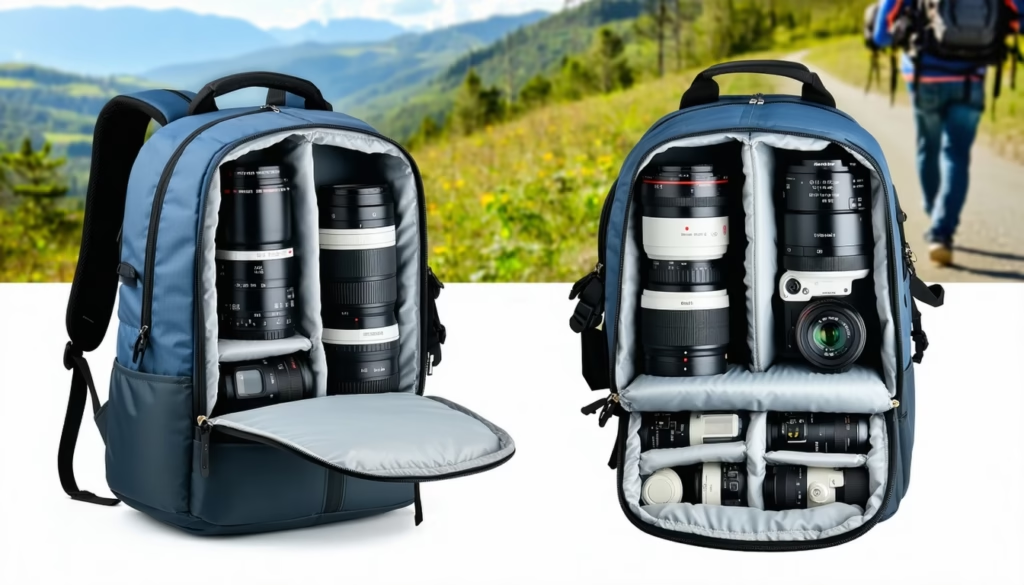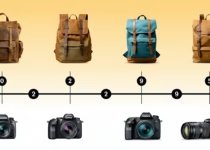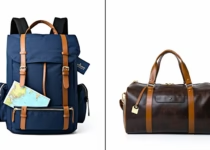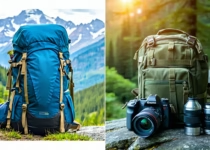Benefits Of Using A Camera Backpack Over A Shoulder Bag

When you’re hauling around camera gear, comfort and protection matter as much as capacity. Imagine lugging a heavy shoulder bag across one side of your body for hours, then swapping it for a well-fitted camera backpack. The benefits of using a camera backpack over a shoulder bag become obvious fast—better weight distribution, more organization, and hands-free convenience top the list. In this article, you’ll discover why a backpack might be your best gear-hauling companion.
Improve Weight Distribution
Carrying all your gear on one shoulder can leave you sore and off-balance after a shoot. A camera backpack spreads weight evenly across both shoulders and your hips, so you avoid that nagging shoulder strain.
Here’s the thing: backpacks often include:
- Padded, adjustable shoulder straps that mold to your body
- A sternum strap for added stability on uneven terrain
- A hip belt that takes the load off your shoulders
With weight shared between shoulders and hips, you’ll feel less fatigue on long shoots or hikes. If you’ve struggled with aches, check out our guide on how to prevent back pain when carrying camera gear.
Increase Gear Protection
Your gear is an investment, so you want padding, structure, and shock absorption. A padded camera backpack cushions your camera bodies, lenses, and flashes better than a floppy shoulder bag.
Key protective features include:
- Thick foam inserts that absorb bumps and drops
- Internal dividers to keep items from jostling each other
- Rigid frames or semi-rigid panels that maintain shape
Shoulder bags often rely on a thin layer of padding and can collapse when empty, leaving your kit vulnerable. To see how pro shooters guard their DSLR bodies, peek at how to protect your DSLR gear in a backpack.
Optimize Storage Capacity
Need room for extra lenses, filters, and a tripod? Backpacks typically offer more volume than shoulder bags without looking oversized.
Most camera backpacks feature:
- 20–30 liter main compartments that fit multiple bodies
- Side pockets for water bottles, snacks, or cables
- Top pockets for memory cards, keys, and wallet
Shoulder bags max out around 10–15 liters, so you’ll juggle gear between hands or drop extras in a secondary bag. If you often pack a tripod, learn how to carry a tripod using a camera backpack without sacrificing space.
Enhance Organization Options
Mix and match inserts, dividers, and pouches to build a system that fits your workflow. Shoulder bags usually have one big interior, meaning you dig around for the right lens.
With a backpack, you can:
- Use modular dividers to create custom cubbies
- Color-code inserts for quick lens swaps
- Stow small items in zippered side or lid pockets
Here’s a quick way to get started: follow our tips on how to customize a camera backpack with inserts and transform chaos into order.
Enjoy Hands-Free Convenience
Ever tried shooting street scenes with one hand holding a shoulder bag? It’s awkward and slow. A backpack frees both your hands so you can focus on framing that perfect shot.
Benefits include:
- Instant camera access via side or top zips
- Freedom to climb rails, scramble rocks, or ride a bike
- A stable carry method in crowded areas
For urban explorers, check out using a camera backpack for street photography and see how hands-free gear helps you capture candid moments.
Expand Weatherproofing Benefits
Rain, dust, and snow can ruin electronics. Many camera backpacks come with built-in rain covers or water-resistant fabrics that seal out moisture far better than canvas shoulder bags.
Look for:
- Water-resistant zippers and taped seams
- An integrated rain cover stored in a hidden pocket
- Fabric rated for UV and mildew resistance
If you shoot outdoors a lot, our post on what to look for in a waterproof camera backpack dives deeper into rugged materials and protective coatings.
Boost Travel Security
Traveling with expensive camera gear raises concerns about theft and airport checks. A backpack with anti-theft features is harder for pickpockets to raid than a sidebag.
Security perks often include:
- Lockable zippers and hidden compartments
- Cut-resistant straps and panels
- TSA-friendly laptop sleeves for quick scans
You can explore top options in our roundup of camera backpacks with anti-theft design to buy now.
Customize Your Setup
Your shooting style evolves. Whether you add a drone or swap to a mirrorless kit, you want a backpack that adapts.
Think about:
- Removable dividers for changing gear layouts
- MOLLE-style webbing (modular attach-points) for straps and pouches
- Interchangeable color-coded inserts for fast swaps
For step-by-step guidance, see how to customize a camera backpack with inserts and build a system that grows with you.
Select the Right Backpack
Not all camera backpacks are created equal. You’ll want to match size, shape, and features to how and where you shoot.
Checklist for your next purchase:
- Capacity: match liters to your typical gear load
- Access style: top-loader, side-loader, or front-loader
- Comfort: padded straps, ventilated back panel, hip belt
- Special features: laptop sleeve, tripod holder, rain cover
If travel is your thing, read how to choose the right camera backpack for travel before hitting “add to cart.”
Backpack vs Shoulder Bag Comparison
| Feature | Camera Backpack | Shoulder Bag |
|---|---|---|
| Weight Distribution | Even across the shoulders and hips | Concentrated on one shoulder |
| Storage Volume | 20–30 liters typically | 10–15 liters |
| Organization | Modular dividers, multiple pockets | Single compartment, few pockets |
| Protection | Thick foam padding, rigid panels | Thin padding, collapsible |
| Hands-Free Use | Yes, backs stay clear | No, bag blocks one arm |
| Weatherproofing | Often water-resistant, rain cover | Rarely water-resistant |
| Security | Lockable zips, hidden pockets | Open flaps, easy access |
FAQs
What weight capacity should a camera backpack have?
Aim for 20–30 liters if you carry multiple bodies, lenses, and accessories. Smaller kits can fit in 10–15 liter packs.
Can I use a regular hiking backpack for camera gear?
You can, but you’ll need padded inserts to keep lenses and bodies safe. A purpose-built camera backpack has ready-made dividers.
How often should I clean my camera backpack?
Every 3–6 months, rinse out crumbs, vacuum interior, and wipe down fabric. For detailed steps, see how to clean and maintain a camera backpack.
Are camera backpacks TSA-friendly?
Many models include a laptop compartment that flips open flat for quick screening. Look for “TSA-friendly” in the specs.
Can a camera backpack hold a tripod?
Yes, most have side, front, or bottom straps designed for tripods. Check our post on how to carry a tripod using a camera backpack for methods.
Should I choose a sling bag instead of a backpack?
A sling bag is lighter and faster to swing around, but it lacks the capacity and weight balance of a full backpack.
Conclusion
Switching from a shoulder bag to a dedicated camera backpack offers clear gains in comfort, capacity, and gear protection. You’ll carry more, feel less strain, and keep your kit organized and ready.
Give a camera backpack a try on your next shoot, and notice how much easier it is to focus on capturing great images instead of hauling heavy gear.


